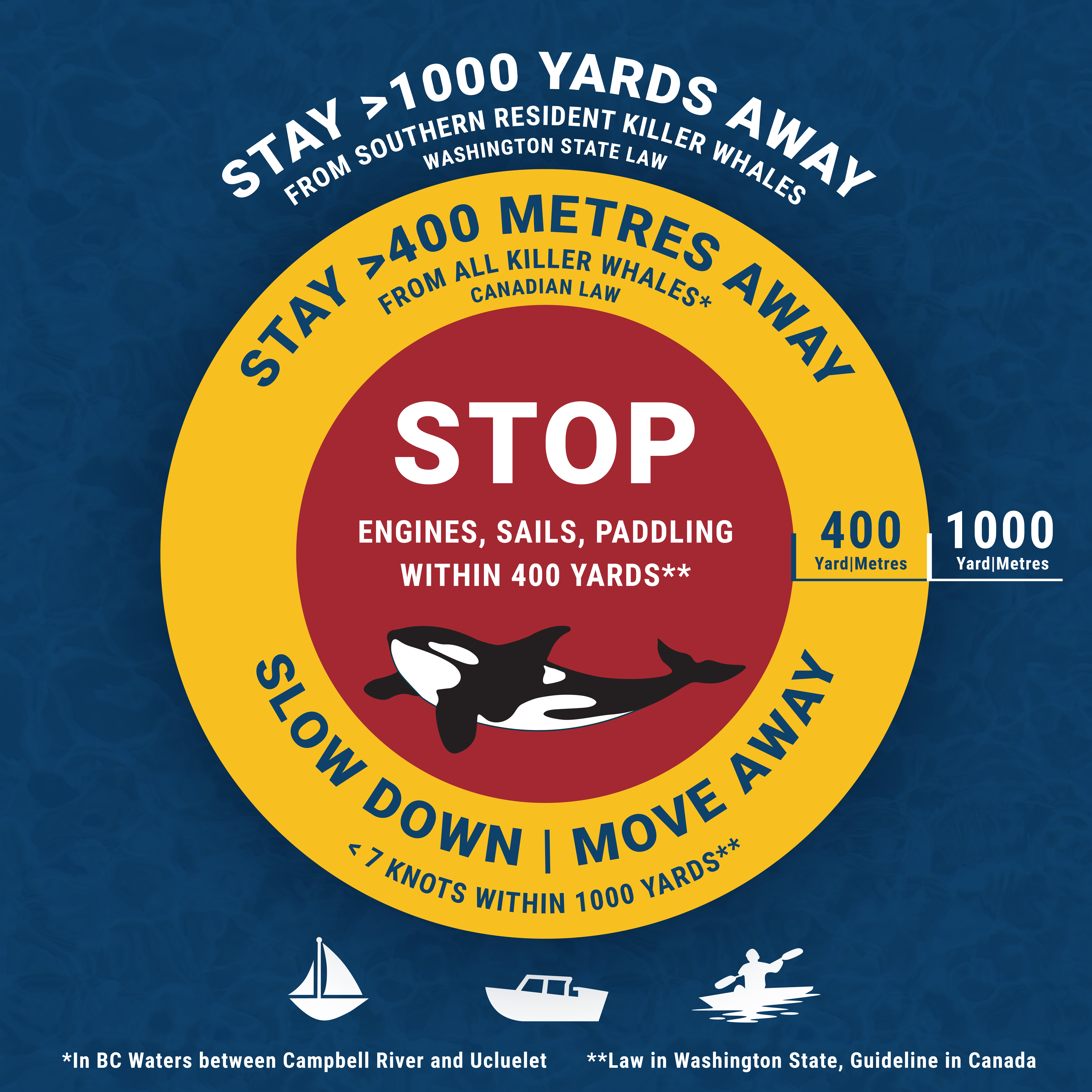Killer Whales
Killer whales have special protection in Canadian and U.S. waters. Be sure to educate yourself about new protections, including regulations with specific distances and recommendations for viewing killer whales.
The Salish Sea is a transboundary region overseen by Canada, the United States and Washington State. Here is a broad look at the regulations regarding operating vessels around killer whales, specifically Southern Resident killer whales or orcas. Additionally, all marine mammals are protected in Canada and the United States. Humans and vessels are required to stay 100 metres/yards away from all other marine mammals and 200 metres/yards from whales, dolphins or porpoises if they are resting or with their calf.

United States Regulations
In the US, Southern Resident killer whales (SRKW) are listed as Endangered under the Endangered Species Act. In 2023, Washington’s Governor Jay Inslee signed into law new regulations governing whale watching in the State of Washington. Federal regulations also still apply to all killer whales in the inland waters of Washington state.
Mandatory measures:
- Boaters must stay 1,000 yards* from Southern Resident killer whales.
- Boaters must go slow (<7 knots) within ½ mile of Southern Resident killer whales.
- Boaters must disengage engine(s) if Southern Resident killer whales appear within 400 yards.
- Boaters must stay 200 yards from other killer whales (Bigg’s/Transient killer whales).
- Boaters must not park in the path within 400 yards of other killer whales (Bigg’s/Transient killer whales)
NOTE: It can be difficult to determine different types of killer whales, especially at a distance when you’re underway. When in doubt, err on the side of caution, treat them as endangered, and follow the appropriate regulations and guidelines.
*There are some areas in the Salish Sea where navigable channels are narrower than 1,000 yards. If you encounter Southern Resident killer whales and you are greater than 400 yards away from the whales, you can motor slowly (under 7 knots) away and out of their path of travel. If you are closer than 400 yards, you must disengage your engine(s) and wait for the whales to pass.
Learn more about Washington State Regulations and United States Federal Regulations.
Canadian Regulations
In Canada, Southern Resident killer whales (SRKW) are listed as Endangered under the Species at Risk Act (SARA) and managed, in part, under the Marine Mammal Regulations of Canada’s Fisheries Act. Additionally, under the Canada Shipping Act, 2001 the Minister of Transport Canada has the authority to make regulations respecting the protection of the marine environment from the impacts of navigation and shipping activities. In April 2024, the Government of Canada announced updated management measures to support the recovery of the Southern Residents, including a range of mandatory and voluntary measures designed to support prey availability and reduce physical and acoustic disturbance to SRKW.
Mandatory measures:
- Vessels must stay 400m away and must not position themselves in the path of killer whales in southern BC coastal waters between Campbell River and just north of Ucluelet until May 31, 2024, as per the Interim Order enacted under the Canada Shipping Act.
- The Marine Mammal Regulations are in effect year-round. This requires staying:
- 200 metres away from all killer whales in Canadian Pacific waters other than those described above
- 200 metres away from all whales, porpoises and dolphins when in resting position or with a calf
- 100 metres for other whales, porpoises and dolphins
- The following areas will be closed to salmon fishing for both commercial and recreational harvesters:
- Swiftsure Bank and Juan de Fuca Strait: Following the expiry of chinook non-retention measures until October 31, 2024, in parts around Swiftsure Bank (closure start date to be communicated in June).
- Gulf Islands: This area’s closures will go into effect following the first confirmed presence of SRKW after May 1 and will be in place until November 30.
- Mouth of the Fraser River: Closures in place from August 1 to September 30, 2024.
- Interim Sanctuary Zones (ISZs) are in effect from June 1 to November 30 in key portions of Southern Resident killer whale critical habitat to further reduce acoustic and physical disturbance from vessels (see map for more details).
- Vessel traffic (including fishing) will be prohibited in ISZs off North Pender and Saturna Islands as per the Interim Order enacted under the Canada Shipping Act. Some exceptions will apply, including vessels involved in Indigenous fishing for food, social or ceremonial purposes and vessels involved in emergency response.
- From June 1 until November 30, all vessels are required to slow down to a maximum of 10 knots around Swiftsure Bank (Some limited exceptions may apply. This measure is mandatory and separate from the voluntary slowdowns coordinated by the ECHO Program. See map for more details):
- In a portion of Subarea 121-1
- In portions of Subareas 121-1, 121-2 and 21-0: near the mouth of the Nitinat River from Carmanah Point to Longitude 125 degrees west
Learn more about all of the 2024 management measures here.
Trans-Boundary Guidelines for the US and Canada
Apply to all whales, porpoises, dolphins, seals, sea lions, any animal hauled out and nesting birds.
- KNOW BEFORE YOU GO. Educate yourself on local marine life and regulations before getting underway.
- BE ALERT and CAUTIOUS on the water. Have your family and friends help to scan for nearby marine life, especially in areas with known or suspected marine wildlife activity, or in narrow or tight areas of navigation.
- LOOK IN ALL DIRECTIONS and ALWAYS GO SLOW (<7 knots) when in the vicinity of any marine wildlife. If you suspect but aren’t certain marine wildlife are near, slow to a stop and assess the situation.
- PLACE ENGINE into neutral and allow all animals space to pass if they approach your vessel or surface within the allowable distance.
- BE PREPARED to move away or shut down if nearby animals change speed and/or direction.
- DO NOT position your vessel in front or behind wildlife.
- STAY on the OFFSHORE side of all wildlife to lessen disturbance along the shoreline.*
- AVOID moving through and disturbing groups of any marine animal. DISCOURAGE bow or stern riding by holding course and gradually reducing speed.
- LIMIT any wildlife viewing time to 30 minutes or less to lessen cumulative impact of vessels on wildlife.
- NEVER approach an animal in distress. Contact your local marine mammal response network to report a sick, stranded, entangled, or dead marine animal.
- DID YOU SEE A WHALE? Help fellow boaters Be Whale Wise by flying your Whale Warning Flag and reporting your sighting to your local sightings network.
* Kayakers and paddlers should follow Kayak Education Leadership Program (K.E.L.P.) guidelines to stay INSHORE of wildlife, raft up, secure themselves, and stop paddling until whales have passed beyond regulation distance. Never paddle towards whales. Visit the K.E.L.P section on the Be Whale Wise website https://www.bewhalewise.org/kelp/ for more information.
The noise and close proximity of unmanned aerial vehicles (UAV)/drones can disturb wildlife in the water or on land. Drones can disturb marine mammals, so are discouraged for viewing marine mammals unless appropriate permits are obtained. To prevent disturbances from an unmanned aerial vehicle (UAV/drone) over the marine environment, operators must use extreme caution. Fly during daylight hours, keep your drone in sight and limit your viewing time to reduce the cumulative impact.
If viewing marine mammals from the air using a drone:
(1) maintain a 1,000-foot minimum altitude within a 0.5 nautical mile (approx. 3,000ft radius) of a marine mammal, and
(2) avoid flight maneuvers around marine mammals (on land or in the water), as these actions may cause stress or alter animal behavior.
Operators should note applicable US FAA regulations and Canadian Aviation Regulations for the airspace in which they are operating. Know and follow all local regulations – although these rules are technically guidelines in the US, in Canada it’s the law.
